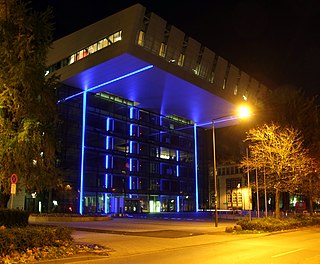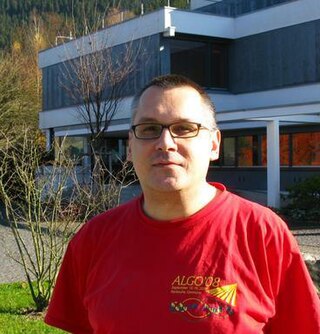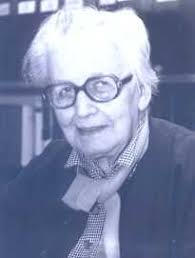
The stator is the stationary part of a rotary system, found in electric generators, electric motors, sirens, mud motors or biological rotors. Energy flows through a stator to or from the rotating component of the system. In an electric motor, the stator provides a magnetic field that drives the rotating armature; in a generator, the stator converts the rotating magnetic field to electric current. In fluid powered devices, the stator guides the flow of fluid to or from the rotating part of the system.

RWTH Aachen University, in German Rheinisch-Westfälische Technische Hochschule Aachen, is a German public research university located in Aachen, North Rhine-Westphalia, Germany. With more than 47,000 students enrolled in 144 study programs, it is the largest technical university in Germany.

University of Erlangen–Nuremberg is a public research university in the cities of Erlangen and Nuremberg in Bavaria, Germany. The name Friedrich–Alexander comes from the university's first founder Friedrich, Margrave of Brandenburg-Bayreuth, and its benefactor Alexander, Margrave of Brandenburg-Ansbach.

The Gottfried Wilhelm Leibniz Prize, or Leibniz Prize, is awarded by the German Research Foundation to "exceptional scientists and academics for their outstanding achievements in the field of research". Since 1986, up to ten prizes have been awarded annually to individuals or research groups working at a research institution in Germany or at a German research institution abroad. It is considered the most important research award in Germany.

The Nuremberg S-Bahn is an S-Bahn network covering the region of Nuremberg, Fürth and Erlangen which started operations in 1987 and is now integrated into the Greater Nuremberg Transport Association. The full length of the five current lines is about 277.6 kilometres.

Akaflieg is an abbreviation for Akademische Fliegergruppe, groups of aeronautical engineering students from individual German Technical Universities, pre and postwar, who design aircraft, often gliders.
Peter Wasserscheid is a German chemist and professor for chemical reaction engineering at the University of Erlangen-Nuremberg. Together with Matthias Beller he won the Gottfried Wilhelm Leibniz Prize in 2006.
Knut W. Urban is a German physicist. He has been the Director of the Institute of Microstructure Research at Forschungszentrum Jülich from 1987 to 2010.

Sabina Jeschke is a German university professor for information sciences in mechanical engineering at the RWTH Aachen University. As of 10 November 2017, she was named member of the management board of Deutschen Bahn AG for digitalization and technology. She is also the director of the Cybernetics Lab IMA/ZLW & IfU. In the summer semester of 2017, she is on sabbatical leave to develop her research in the area of artificial consciousness, and is involved in building a think tank "Strong Artificial Intelligence" at the Volvo Car Corporation in Göteborg. Since May 2015, Jeschke has been a member of the supervisory board of Körber AG, since April 2012 chairman of the board of VDI Aachen. Beginning of January 2023 she took on an additional position as a senior advisor at Arthur D. Little.
Johnny K. Larsson is a Swedish engineer and Technical Specialist, Body-in-White Joining Technologies, at Volvo Car Corporation, where he focuses on joining technologies for passenger car body structures.
Leif Kobbelt is a German university professor for Computer Science with a specialization in Computer Graphics. Since 2001 he is the head of the Institute for Computer Graphics and Multimedia at RWTH Aachen university.
Bernhard H. Walke is a pioneer of mobile Internet access and professor emeritus at RWTH Aachen University in Germany. He is a driver of wireless and mobile 2G to 5G cellular radio networks technologies. In 1985, he proposed a local cellular radio network comprising technologies in use today in 2G, 4G and discussed for 5G systems. For example, self-organization of a radio mesh network, integration of circuit- and packet switching, de-centralized radio resource control, TDMA/spread spectrum data transmission, antenna beam steering, spatial beam multiplexing, interference coordination, S-Aloha based multiple access and demand assigned traffic channels, mobile broadband transmission using mm-waves, and multi-hop communication.

Rudolf Paul Maria Henke is a physician and politician of the Christian Democratic Union (CDU) who served as a member of the German Bundestag from 2009 until 2021.

Gerhard J. Woeginger was an Austrian mathematician and computer scientist who worked in Germany as a professor at RWTH Aachen University, where he chaired the algorithms and complexity group in the department of computer science.

In electrical engineering, coil winding is the manufacture of electromagnetic coils. Coils are used as components of circuits, and to provide the magnetic field of motors, transformers, and generators, and in the manufacture of loudspeakers and microphones. The shape and dimensions of a winding are designed to fulfill the particular purpose. Parameters such as inductance, Q factor, insulation strength, and strength of the desired magnetic field greatly influence the design of coil windings. Coil winding can be structured into several groups regarding the type and geometry of the wound coil. Mass production of electromagnetic coils relies on automated machinery.
A Master of Science in Data Science is an interdisciplinary degree program designed to provide studies in scientific methods, processes, and systems to extract knowledge or insights from data in various forms, either structured or unstructured, similar to data mining.

Doris (Elfriede) Schachner née Korn was the first female German professor for Mineralogy and Honorary Senator of the RWTH Aachen University.
Albert Ziegler is a German psychologist and the Chair Professor of Educational Psychology and Research on Excellence at the Friedrich-Alexander-University Erlangen Nürnberg.

The Institut für Kunststoffverarbeitung in Industrie und Handwerk (IKV), the Institute for Plastics Processing in Industry and Trade at the Rheinisch-Westfälische Technische Hochschule Aachen, Germany, is a teaching and research institute for the study of plastics technology. It stands for practice-oriented research, innovation and technology transfer. The focus of the IKV is the integrative view of product development in the material, construction and processing sectors, in particular in plastics and rubber. The sponsor is a non-profit association that currently includes around 300 companies from the plastics industry worldwide and through which the institute maintains a close connection between industry and science. In addition, the IKV is a member of the Arbeitsgemeinschaft industrieller Forschungsvereinigungen "Otto von Guericke" (AiF).














